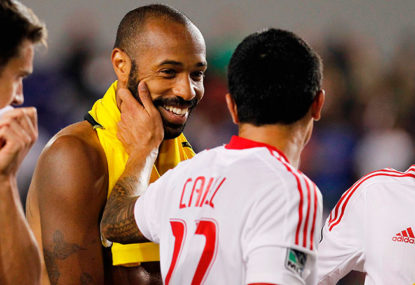For every inch that Australian football grows, our American friends are taking continental leaps in their domestic scene – and there’s much we can take away from how Major League Soccer does its business.
Expansion ain’t no walk in the park – it’s a dangerous cocktail of money, politics and geography. Mix it right, and the rewards can be tremendous. Get it wrong, and there’ll be a bitter taste on tongues for years.
Though when you strip away the aforementioned money, politics and geography, there’s a glaring issue, particularly in an Australian context, which needs to carry a decent level of prioritisation.
And it’s an issue that MLS does extremely well to address: the effect on the player talent pool.
On Wednesday afternoon (red white and blue time), the 2014 MLS Expansion Draft will be held between league newcomers New York City FC and Orlando City SC.
The draft is designed to help the two incoming franchises stock their rosters with existing MLS talent and ease the burden of starting a football club from scratch.
Both teams will be given 10 picks each from a spread of 240 available players.
Yesterday, each of the 18 established MLS clubs submitted two lists: one list with the names of players who are available for drafting, and one list of the names of players who are protected from being poached.
Each of the 18 teams is able to nominate 11 players for this protected list. Players who are classified as homegrown (local players who have graduated through their club’s development academies) or are sponsored by the Generation Adidas venture (a program which allows young players to bypass the college system) are also automatically protected.
This means that everyone else is fair game to NYFC and Orlando. Interestingly, one name in particular stands out in this pool of unprotected players: our very own Tim Cahill.
It’s possibly the biggest hint yet that Cahill’s tenure with the Red Bulls is over, and there’s now every chance that he could be lining up for new boys NYFC next year alongside Frank Lampard and old mate David Villa.
As one would expect, there’s a litany of rules and stipulations to go along with the draft. Notable ones include:
• No team can lose more than two players in the draft
• Once a player has been claimed from a club’s unprotected list, said club then have the option of protecting a previously unprotected player
• A player with a contract that is set to expire at end of season is still considered to be part of his team’s roster; it is then up for the club to decide whether to protect him or not
• The 18 clubs are restricted in the number of international players that they make available for drafting
• NYCFC and Orlando have the right to renegotiate a draft player’s salary without having to place said player on waivers or giving his previous club a right of first refusal
You can read a full list of the 2014 Expansion Draft rules here.
The draft is now part of the standard expansion protocol for MLS.
An Expansion Draft was last held in 2011 ahead of the Montreal Impact’s arrival on the scene, and it’s expected that one will be held in 2016 before new franchises in Atlanta and Los Angeles join the fray.
In short, MLS have worked out a system that effectively considers how expansion impacts the league’s talent pool.
As the A-League stands on the precipice of its own period of growth and change, it’d do well to address the issue in a similar way.
If such a system were to be implemented in the A-League, naturally it would require substantial alterations to the Australian footballing fabric – particularly in regards to the salary cap and youth development structures.
Of course, it’s unfair to compare MLS with the A-League. MLS has 11 solid years on our league, and is also fed by the capitalist beast that is American sports; earlier this year for example, MLS announced a major television deal worth a reported $720 million.
Though with the A-League having a significantly smaller available talent pool than America, it’s important that we stay mindful of how we manage our most precious resource: players.
It’d be hard to argue against the fact that we live in a nation where the talent pool is beginning to spread rather thin. And when the next two franchises are announced in the coming years, this situation will be amplified.
The Western Sydney Wanderers were able to put together unwanted parts to assemble a team worthy of silverware. But do we have an existing talent pool that’ll support a similar start-up twice, three times, four times over? I’m not sure.
We could certainly dip into our state-based leagues, though as I pointed out earlier this year, there’s still a considerable gulf in ability between these leagues and the top tier.
The National Youth League could well be mined for gems, but the jury is still out on whether or not the league is achieving what it should be – another article, for another time.
What we don’t want is for incoming teams to be left high and dry when it comes to assembling a playing roster. Having an even playing field is a hallmark of the A-League, and if were to lose that we’d be losing one of the main draw cards of our game.
A draft may not be the answer, but when it comes to our talent pool, there’s no questioning that the A-League needs to prepare for life before expansion.





























































































